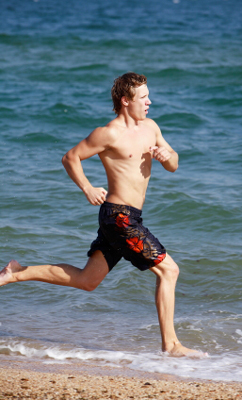|
[?]Subscribe To This Site
|
Running On Sand - The Florida Beach WorkoutBurn belly fat on the the beautiful Florida beachRunning on sand provides us a great workout here on the Florida beach. Sand running is a great way to burn belly fat with interval training. You'll work much harder with beach running than on pavement. For the past couple of years, a small group of us has gotten together about 45 minutes before sunrise here on the Florida Gulf Beaches west of St. Petersburg to do about 30 minutes of interval training twice a week, with a steady run on the in-between training day. All of us have lost at least an inch on our waists and all of us have gotten faster in the 5K. Best of all, though, we get to start the day in Paradise. Away from traffic and noise, smelling clean salt air, and seeing the locale we consider the most beautiful on the planet, come alive. 
* Count on getting tired a lot easier. Sand running makes you work much harder without covering near the distance associated with how you are feeling. * Your muscles, ligaments, and tendons all must adapt to beach running. Start slowly and run about 1/2 of what you normally would for the first 5-6 workouts. DO NOT start with hard interval workouts. * Your first several runs should be where there is LESS depth in the sand. Allow your joints and muscles to get used to running on such a yielding and uneven surface. * Running on sand is deceptive. It creates less of an impact on your joints, but it puts strain on ankles, knees, and hips because of unevenness and lack of surface density. You must build up to running several miles on sand. It WILL NOT happen in 3 or 4 workouts. * Deep sand is just like resistance exercise. It creates strength and power...BUT, it can easily strain foot muscles, calf muscles, and your Achilles tendon. Run closer to the water where the sand is more firmly packed for the first 4-6 weeks. * You must take into account the pitch (slope) of the beach when running close to the water. Excessive camber puts tremendous stress on your downhill leg. Running right above the high-tide mark or right on the low-tide bar are preferable. Running on the area in-between can lead to injury * Guys who run barefoot say this is how The Universe wanted man to run and his feet are more easily adaptable to sand running than the composite material on the bottom of running shoes. * Guys who run barefoot claim you have less restrictions through the full range of motion of the natural foot and this will increase strength in the small muscles that form it. * Guys who run with shoes on sand say running barefoot can lead to the increased incidence of tendonitis and the occurrence of plantar fascitis because of the inconsistent surface. * Guys who run with shoes say there is far more chance of injury running barefoot because of the lack of foot support. * Guys who run barefoot say sand gets in shoes and it makes it no fun because they are heavy and uncomfortable. (Give me a break, guys.) As you can see, running on sand has just as many opinions about the right way to do it as does running on forest trails. I wear shoes all the time because I do not see as well as I did 20 years ago and I do not want to step on a pull-tab, broken piece of beer bottle, or a fish hook. Be prepared to breathe hard. Beach running can make your heart and lungs work more than they are used to.
|
|





 Boy, this is the age-old question when running on the Florida beach is discussed (and cussed.) There are strong resolving arguments on both sides.
Boy, this is the age-old question when running on the Florida beach is discussed (and cussed.) There are strong resolving arguments on both sides.